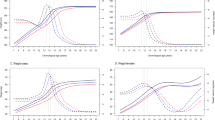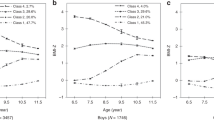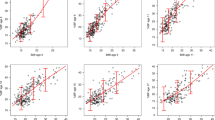Abstract
Background:
Diabetes is closely linked to obesity, and obesity rates climb during adolescence for reasons that are not clear. Energy efficiency is important to obesity, and we describe a temporary but substantial fall in absolute energy expenditure, compatible with improved energy efficiency, during the rapid growth phase of puberty.
Methods:
In a longitudinal cohort study lasting 10 years, we measured voluntary energy expenditure as physical activity (PA) by accelerometry, involuntary energy expenditure as resting energy expenditure (REE) by oxygen consumption, body mass index (BMI) and body composition by dual energy X-ray absorptiometry annually on 10 occasions from 7 to 16 years in the 347 children of the EarlyBird study. We used mixed effects modelling to analyse the trends in REE and their relationship to BMI, lean mass (LM), fat mass (FM), age, PA and pubertal stage.
Results:
Relative REE and total PA fell during puberty, as previously described, but the longitudinal data and narrow age-range of the cohort (s.d.±4m) revealed for the first time a substantial fall in absolute REE during the period of maximum growth. The fall became clearer still when adjusted for FM and LM. The fall could not be explained by fasting insulin, adiponectin, leptin, luteinising hormone or follicle stimulating hormone.
Conclusions:
There appears to be a temporary but substantial reduction in energy expenditure during puberty, which is unrelated to changes in body composition. If it means higher energy efficiency, the fall in REE could be advantageous in an evolutionary context to delivering the extra energy needed for pubertal growth, but unfavourable to weight gain in a contemporary environment.
This is a preview of subscription content, access via your institution
Access options
Subscribe to this journal
Receive 12 print issues and online access
$259.00 per year
only $21.58 per issue
Buy this article
- Purchase on Springer Link
- Instant access to full article PDF
Prices may be subject to local taxes which are calculated during checkout




Similar content being viewed by others
References
Hannon TS . Childhood obesity and type 2 diabetes mellitus. Pediatrics 2005; 116: 473–480.
Pinhas-Hamiel O, Zeitler P . The global spread of type 2 diabetes mellitus in children and adolescents. J Pediatrics 2005; 146: 693–700.
Ball EJ, O'Connor J, Abbott R, Steinbeck KS, Davies PS, Wishart C et al. Total energy expenditure, body fatness, and physical activity in children aged 6-9 y. Am J Clin Nutr 2001; 74: 524–528.
Jago R, Wedderkopp N, Kristensen PL, Møller NC, Andersen LB, Cooper AR et al. Six-year change in youth physical activity and effect on fasting insulin and HOMA-IR. Am J Prev Med 2008; 35: 554–560.
Metcalf BS, Hosking J, Jeffery AN, Henley WE, Wilkin TJ . Exploring the adolescent fall in physical activity. Med Sci Sports Exerc 2015; 47: 2084–2092.
Cannon B . Brown adipose tissue: function and physiological significance. Physiol Rev 2004; 84: 277–359.
Rogers NH . Brown adipose tissue during puberty and with aging. Ann Med 2014; 47: 142–149.
Sun M, Gower BA, Bartolucci AA, Hunter GR, Figueroa-Colon R, Goran MI . A longitudinal study of resting energy expenditure relative to body composition during puberty in African American and white children. Am J Clin Nutr 2001; 73: 308–315.
Wang Z, Heshka S, Zhang K, Boozer CN, Heymsfield SB . Resting energy expenditure: systematic organization and critique of prediction methods*. Obesity 2001; 9: 331–336.
Bitar A, Fellmann N, Vernet J, Coudert J, Vermorel M . Variations and determinants of energy expenditure as measured by whole-body indirect calorimetry during puberty and adolescence. Am J Clin Nutr 1999; 69: 1209–1216.
Wang Z . High ratio of resting energy expenditure to body mass in childhood and adolescence: a mechanistic model. Am J Hum Biol 2012; 24: 460–467.
Sinclaire D . Human Growth After Birth. Oxford Univesity Press: London, 1973.
Voss LD, Kirkby J, Metcalf BS, Jeffery AN, O'Riordan C, Murphy MJ et al. Preventable factors in childhood that lead to insulin resistance, diabetes mellitus and the metabolic syndrome: The EarlyBird Diabetes Study I. J Pediatr Endocrinol Metab 2003; 16: 1211–1224.
Puyau MR, Adolph AL, Vohra FA, Butte NF . Validation and calibration of physical activity monitors in children. Obesity Res 2002; 10: 150–157.
Schmitz KH, Treuth M, Hannan P, McMurray R, Ring KB, Catellier D et al. Predicting energy expenditure from accelerometry counts in adolescent girls. Med Sci Sports Exerc 2005; 37: 155–161.
Basterfield L, Adamson AJ, Frary JK, Parkinson KN, Pearce MS, Reilly JJ . Longitudinal study of physical activity and sedentary behavior in children. Pediatrics 2010; 127: e24–e30.
Metcalf BS, Curnow JSH, Evans C, Voss LD, Wilkin TJ . Technical reliability of the CSA activity monitor: The EarlyBird Study. Med Sci Sports Exerc 2002; 34: 1533–1537.
Nicholson MJ, Holton J, Bradley AP, Beatty PC, Campbell IT . The performance of a variable-flow indirect calorimeter. Physiol Meas 1996; 17: 43–55.
Margulies L, Horlick M, Thornton JC, Wang J, Ioannidou E, Heymsfield SB . Reproducibility of pediatric whole body bone and body composition measures by dual-energy X-Ray absorptiometry using the GE Lunar Prodigy. J Clin Densitom 2005; 8: 298–304.
Taylor SJ, Whincup PH, Hindmarsh PC, Lampe F, Odoki K, Cook DG . Performance of a new pubertal self-assessment questionnaire: a preliminary study. Paediatr Perinat Epidemiol 2001; 15: 88–94.
Krueger C . A comparison of the general linear mixed model and repeated measures ANOVA using a dataset with multiple missing data points. Biol Res Nurs 2004; 6: 151–157.
Hosking J, Henley W, Metcalf BS, Jeffery AN, Voss LD, Wilkin TJ . Changes in resting energy expenditure and their relationship to insulin resistance and weight gain: a longitudinal study in pre-pubertal children (EarlyBird 17). Clin Nutr 2010; 29: 448–452.
Pourhassan M, Humeida H, Braun W, Gluer C, Muller M . Effect of Age on Detailed Body Composition and Resting Energy Expenditure in Normal Weight, Overweight and Obese Children and Adolescents. European Obesity Summit, EOS 2016: Gothenburg, Sweden, 2016.
Story M, Stang J Guidelines for Adolescent Nutrition Services. University of Minnesota: Minneapolis, MN 2005, p 239.
Santosa S, Khosla S, McCready LK, Jensen MD . Effects of estrogen and testosterone on resting energy expenditure in older men. Obesity 2010; 18: 2392–2394.
Burt MG, Gibney J, Hoffman DM, Umpleby AM, Ho KK . Relationship between GH-induced metabolic changes and changes in body composition: a dose and time course study in GH-deficient adults. Growth Hormone IGF Res 2008; 18: 55–64.
Ruige JB, Ballaux DP, Funahashi T, Mertens IL, Matsuzawa Y, Van Gaal LF . Resting metabolic rate is an important predictor of serum adiponectin concentrations: potential implications for obesity-related disorders. Am J Clin Nutr 2005; 82: 21–25.
Pannacciulli N, Bunt JC, Ortega E, Funahashi T, Salbe AD, Bogardus C et al. Lower total fasting plasma adiponectin concentrations are associated with higher metabolic rates. J Clin Endocrinol Metab 2006; 91: 1600–1603.
Hosking J, Metcalf BS, Jeffery AN, Gardner D, Voss LD, Wilkin TJ . Resting energy expenditure, adiponectin and changes in body composition of young children (EarlyBird 34). Int J Pediatr Obes 2008; 3: 46–51.
Mostazir M, Jeffery A, Voss L, Wilkin T . Childhood obesity: evidence for distinct early and late environmental determinants a 12-year longitudinal cohort study (EarlyBird 62). Int J Obes Relat Metab Disord 2015; 39: 1057–1062.
Acknowledgements
We acknowledge the help of Karen Brookes and Val Morgan in maintaining the EarlyBird cohort. We are grateful to the Bright futures trust, Fountain Foundation, BUPA Foundation, EarlyBird Diabetes Trust and countless individual donors who made this study possible.
Author information
Authors and Affiliations
Corresponding author
Ethics declarations
Competing interests
The authors declare no conflict of interest.
Rights and permissions
About this article
Cite this article
Mostazir, M., Jeffery, A., Hosking, J. et al. Evidence for energy conservation during pubertal growth. A 10-year longitudinal study (EarlyBird 71). Int J Obes 40, 1619–1626 (2016). https://doi.org/10.1038/ijo.2016.158
Received:
Revised:
Accepted:
Published:
Issue Date:
DOI: https://doi.org/10.1038/ijo.2016.158
This article is cited by
-
Short sleep duration is associated with specific food intake increase among school-aged children in China: a national cross-sectional study
BMC Public Health (2019)
-
Energy balance-related factors associating with adolescent weight loss intent: evidence from the 2017 National Youth Risk Behavior Survey
BMC Public Health (2019)
-
Gender-dependent association between sleep duration and overweight incidence in CHINESE school children: a national follow-up study
BMC Public Health (2018)



